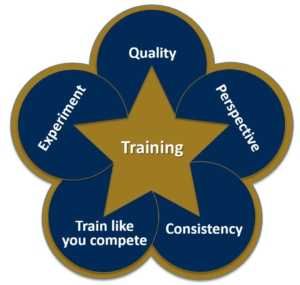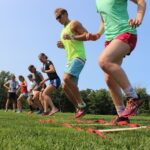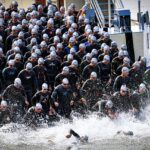 Training is the practical foundation of ski racing success, meaning it’s what you do that determines whether you do or do not achieve your ski racing goals. That’s why it is the third module in my new 12-week online mental training program, which will begin on June 1st. The program provides racers, coaches, and parents with a truly comprehensive and practical approach to the mental side of ski racing.
Training is the practical foundation of ski racing success, meaning it’s what you do that determines whether you do or do not achieve your ski racing goals. That’s why it is the third module in my new 12-week online mental training program, which will begin on June 1st. The program provides racers, coaches, and parents with a truly comprehensive and practical approach to the mental side of ski racing.
In this post, I will describe why training is so vital to ski racing success and the specific mental areas where your efforts in training must be directed. For you to be the best ski racer you can be, you must be serious about your training in every area that impacts your skiing including physical, technical, tactical, and mental.
Training, the third part of my Prime Performance System, is comprised of five essential elements the goal of which is to ensure that you get the most out of your training efforts.
Train Like You Race
The reality is that there is one huge difference between training and races: races matters! How fast you ski and your times and results in training don’t have any value beyond that day. And the fact that racing matters brings with it all sorts of baggage related to expectations, focusing on results, comparing yourself with other racers, and fear of failure. That’s why so many racers train much faster than they race.
Here are two important rules in ski racing. First, whatever you do in races, you must first do in training. If you want to ski technically and tactically well in races, you better get that technique and those tactics down in training first. The same holds true for every other aspect of your race preparations, whether ski tuning, physical readiness, or mental preparation.
Second, whatever you do in training is what you will do in a race. Ideally, the purpose of training is to develop effective skills and habits that will translate into fast skiing on race day. But here’s the problem: racers often practice bad skills and habits in training. For example, if you practice being in the backseat or dropping your hands in training (not intentionally, of course), that’s what you become good at and that’s what comes out in the race.
Whether you practice good or bad skills and habits has a huge impact on your mental preparation. Here’s an example that drives me absolutely crazy. On race day, you go to elaborate lengths to prepare for each race run. Yet, I see racers at the start of training courses leaning on their poles and chatting it up with their friends. What these racers are doing is developing the skills and habits of skiing at about 70% focus and intensity.
So think about what you do on race day to get ready to ski your best and do the same things in training.
Consistency
Consistency is what often separates great racers from good racers. The ability of the Hirschers, Shiffrins, Kristoffersens, and Vonns to go out there, day in and day, week in and week out, month in and month, and year in and year out, is remarkable. The key question is: What makes them so consistent? No doubt innate talent plays a big role, but I would argue that their consistently fast skiing and race results come from consistent preparation in every aspect of their ski racing and life including their physical conditioning, on-snow training efforts, technique and tactics, mental training, nutrition, sleep, and school.
Additionally, their consistently fast skiing comes from consistency of their mind. Regardless of the circumstances, their attitude and confidence are steadfast. They reach their ideal level of physical intensity every run, whether in training or races. These superstars have an unwavering focus and a specific mindset that they adopt before every run. One key to their consistent skiing is a relentlessness that keeps them motivated to keep working hard and never give up. Finally, they have consistent, and positive, reactions to both success and failure; win or lose, they keep on the path that they believe will work for them.
Most importantly, consistently fast skiing will come from consistency in your training efforts. The best way to build this consistency is to have a clearly defined goal for every training session and a structured training routine that you use before every training run. There are three benefits to your training routine. First, It ensures that you maximize every physical and mental area that will impact your training. Second, it will ingrain consistent mental and physical skills and habits. Finally, this routine will ensure that every time you get in the starting gate of a training or race run, you are total prepared to ski your fastest.
Experiment
The only way to improve is to experiment and try new things. The problem is that change is difficult; it takes time and it’s frustrating. Experimentation is uncomfortable because new things are unfamiliar, they don’t feel good, and they don’t usually work right away.
Yet, despite these obstacles, for you to achieve your ski racing goals, you must be open and motivated to try new things, physically, technically, tactically, mentally, and with your equipment. Only through experimentation can you find that precise mixture of those ingredients that will result in consistently fast skiing.
One way that I find effective with experimentation is to go to extremes. For example, with your physical intensity, you can try a few runs really relaxed, a few really fired up, and a few somewhere in the middle. In doing so, you identify what your ideal intensity is.
There’s an old Texas saying: “If all you ever do is all you’ve ever done, then all you’ll ever get is all you’ve ever got.” Which means if you’re not experimenting and trying new things, you’re not getting better. Your goal is to constantly seek out and experiment with new ways to ski faster.
Perspective
We live in a culture in which we are led to believe that everything can be accomplished quickly and with little effort (e.g., communication: social media, fame: reality TV, wealth: get-rich-quick schemes). But the reality is just the opposite. Anything in life worth doing takes commitment, time, and energy including achieving your ski racing goals.
If you buy into the ‘fast and now’ attitude, you are doomed to a ski racing experience filled with frustration, dissatisfaction, and failure. This unhealthy perspective will come face-to-face with the normal challenges of our sport including uneven or no progress in training, and DNFs and poor results in races.
To get the most out of your preparations, you must take the long view on your ski racing. You must see setbacks as normal and expected bumps in the road to your goals, not brick walls that can’t be climbed or knocked down. You need to stay positive and motivated during down periods. You must be focused on the process and the present rather be pulled toward the failures of the past or the results of the future. Ultimately, you must have patience, knowing that chasing your ski racing dreams is a long-term commitment; persistence, knowing that your only chance of success is to keep plugging away; and, finally, perseverance, knowing that you must overcome the inevitable ups and downs of our sport.
Quality
The four elements above are directed toward maximizing the quality and value of your training. The quality of your training will have an immense impact on how you development as a ski racer and the results you produce in races. Specifically, it enables you to get the most out of your training efforts, thereby producing more improvement more quickly. It allows you to make the most efficient and effective use of your training time. Quality training enables you to ingrain effective physical, technical, tactical, and mental skills and habits that will result in consistently fast skiing. Your goal is to engage in high-quality training every run of every day.
Learn more about my new 12-week online mental training program. This 12-week live and interactive program takes everything I know about the mental side of ski racing and offers it in an organized, engaging, and affordable format. I offer team discounts and coaches can attend for FREE with an enrollment of 25 athletes from a team. Plus, parents who want to who want to participate can receive a 2-for-1 couples discount.






